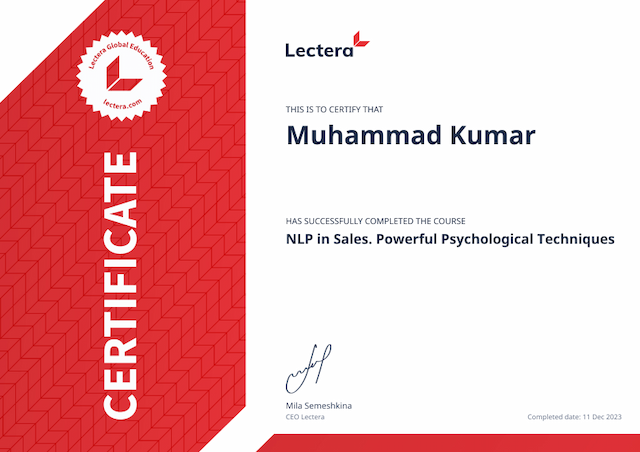NLP in Sales. Powerful Psychological Techniques
Mastering quick and easy sales via learning customer psychology and building trust relationships with them
What you will get:
About this course
- Verbal communication
- Active listening
- Dealing with objections
- Motivation management
- Persuasion
- Non-verbal communication
Course structure
Lesson 2. Enhancing your skills as a seller and decision making techniques
Lesson 3. Verbal tuning techniques: representation, keys, and metaprograms
Lesson 4. Non-verbal adjustment and interpretation: gestures, posture, breathing and distance
Lesson 5. Identifying Customer Needs: the NLP SCORE model, Milton Model and marker words
Lesson 6. Quick sale techniques and anchoring
Lesson 7. How to neutralise customer’s objections prepare for a sale
Lesson 8. Closing the sale and working with NLP
Certificate
Upon successful completion of the course, you will receive a certificate in your email. It will confirm the knowledge and skills you will have acquired.

Reviews
Василий Яриков
Благодаря курсу я научился работать с любыми (я не преувеличиваю - с любыми!) возражениями клиентов. Раньше было сложно продавать, сейчас будто появилась четкая и понятная система. Это невероятно мотивирует на дальнейшую работу. Однозначно рекомендую.
Стас
Совсем недавно прошел курс «НЛП в продажах», и остался более чем доволен. Редко так бывает, что приходишь за чем-то одним, а получаешь намного больше. Тут не только приемы продаж но и техники убеждения, которые работают в любой ситуации и в любых отношениях с людьми. Этот курс открытие для меня. Программа подобрана таким образом, что информация подается легко и быстро запоминается. Многочисленные примеры закрепляют усвоенное. Более чем уверен в том, что это не последний курс, который буду проходить у Лектеры, спасибо большое!
Genry